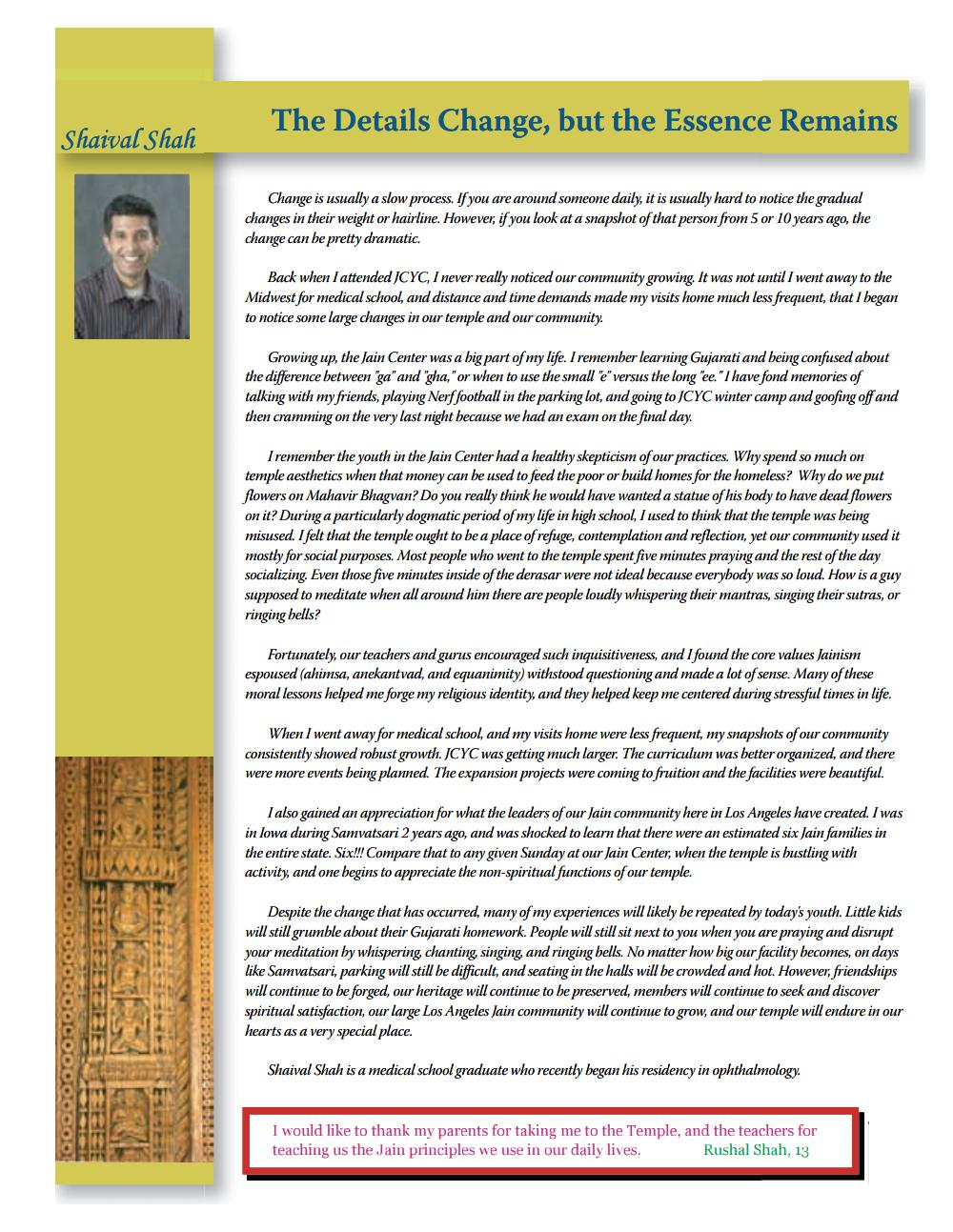________________
Shaival Shah
The Details Change, but the Essence Remains
Change is usually a slow process. If you are around someone daily, it is usually hard to notice the gradual changes in their weight or hairline. However, if you look at a snapshot of that person from 5 or 10 years ago, the change can be pretty dramatic.
Back when I attended JCYC, I never really noticed our community growing. It was not until I went away to the Midwest for medical school, and distance and time demands made my visits home much less frequent, that I began to notice some large changes in our temple and our community.
Growing up, the Jain Center was a big part of my life. I remember learning Gujarati and being confused about the difference between "ga" and "gha," or when to use the small "e" versus the long "ee." I have fond memories of talking with my friends, playing Nerf football in the parking lot, and going to JCYC winter camp and goofing off and then cramming on the very last night because we had an exam on the final day.
I remember the youth in the Jain Center had a healthy skepticism of our practices. Why spend so much on temple aesthetics when that money can be used to feed the poor or build homes for the homeless? Why do we put flowers on Mahavir Bhagvan? Do you really think he would have wanted a statue of his body to have dead flowers on it? During a particularly dogmatic period of my life in high school, I used to think that the temple was being misused. I felt that the temple ought to be a place of refuge, contemplation and reflection, yet our community used it mostly for social purposes. Most people who went to the temple spent five minutes praying and the rest of the day socializing. Even those five minutes inside of the derasar were not ideal because everybody was so loud. How is a guy supposed to meditate when all around him there are people loudly whispering their mantras, singing their sutras, or ringing bells?
Fortunately, our teachers and gurus encouraged such inquisitiveness, and I found the core values Jainism espoused (ahimsa, anekantvad, and equanimity) withstood questioning and made a lot of sense. Many of these moral lessons helped me forge my religious identity, and they helped keep me centered during stressful times in life.
When I went away for medical school, and my visits home were less frequent, my snapshots of our community consistently showed robust growth. JCYC was getting much larger. The curriculum was better organized, and there were more events being planned. The expansion projects were coming to fruition and the facilities were beautiful.
I also gained an appreciation for what the leaders of our Jain community here in Los Angeles have created. I was in lowa during Samvatsari 2 years ago, and was shocked to learn that there were an estimated six Jain families in the entire state. Six!!! Compare that to any given Sunday at our Jain Center, when the temple is bustling with activity, and one begins to appreciate the non-spiritual functions of our temple.
Despite the change that has occurred, many of my experiences will likely be repeated by today's youth. Little kids will still grumble about their Gujarati homework. People will still sit next to you when you are praying and disrupt your meditation by whispering, chanting, singing, and ringing bells. No matter how big our facility becomes, on days like Samvatsari, parking will still be difficult, and seating in the halls will be crowded and hot. However, friendships will continue to be forged, our heritage will continue to be preserved, members will continue to seek and discover spiritual satisfaction, our large Los Angeles Jain community will continue to grow, and our temple will endure in our hearts as a very special place.
Shaival Shah is a medical school graduate who recently began his residency in ophthalmology.
I would like to thank my parents for taking me to the Temple, and the teachers for teaching us the Jain principles we use in our daily lives. Rushal Shah, 13




